#dungeons and dragons 5th edition
Explore tagged Tumblr posts
Text
DND tommorow
I'm DM-ing for the first time for a group of first time players tommorow. I'm putting them in a very small dungeon to fight rats. Do you have any tips?
35 notes
·
View notes
Text
D&D monster: Vengeance Goose
This was inspired by a tumblr post which I've seen in screenshot form on imgur from time to time, though I'm having trouble tracking down the original post; the gist of it is, "don't wish death on your enemies -- wish geese on them. Infinite geese."
This appealed to my sense of humour, hence the following monster statblock (partly cribbed from the 'giant goose' from the 5e supplement Bigby Presents: Glory of the Giants, specifically some of the stats and the Actions section, especially the 'Thunderous Honk' move; it was the most goose-y statblock I could find) and accompanying summoning spell. Both monster and spell are deliberately overpowered jokes, so DMs, be judicious in using them with your table -- but if you do, definitely drop me a line because I'd LOVE to hear how it goes! (There's always one Big Bad Evil Guy who'd be soooooo satisfying to take down via swarm of cactus-wielding geese >:D Mwahahaha!!!)
In my mind, this monster resembles a Canada Goose (albeit larger), but feel free to sub in whichever type of goose you consider to be especially vicious b******s! :D
------
Long ago, a wizard specialising in transmutation magic (and not getting out in the fresh air enough) was seeking a more satisfying means than mere death for getting one over on his enemies. Remembering an incident in his youth and a plant from his homeland, he captured some local geese and magically engineered them to have enhanced aggression and the abilities to single-mindedly pursue a specified target and cast cactus-summoning magic.
Unfortunately for him, his original test subjects got loose and worked out their (very understandable) grudges against him, before escaping and mingling with the local goose population. Their descendants have lost none of their aggression or spellcasting ability, and are known to be violently territorial even by the standards of goose-kind, at least where non-avian intruders are concerned.
A group of adventurers who investigated the wizard's tower after his demise found his notes and managed to reverse-engineer them, creating a spell with which to summon one or more Vengeance Geese into temporary existence to assail an immediately present target. This spell is generally safe for adventuring mages to use; attempting to capture and tame Vengeance Geese from the wild is overwhelmingly discouraged by all reputable druidic organisations and any rangers with half an ounce of sense.
Vengeance Goose
Medium Beast, typically Chaotic Neutral
Armour Class: 16 (natural armour) Hit Points: 120 (16d8+48) Speed: 30ft., fly 30ft.
STR 18 (+4) DEX 14 (+2) CON 17 (+3) INT 12 (+1) WIS 18 (+4) CHA 12 (+1)
Saving Throws Dexterity +8, Constitution +6, Charisma +7
Skills Insight +7, Perception +7, Intimidation +7
Damage Resistances magical bludgeoning/slashing/piercing, force, poison
Damage Immunities piercing (own conjured cacti only), thunder
Condition Immunities blinded, charmed, deafened, exhausted, frightened, paralysed, poisoned
Senses truesight 30ft., darkvision 60 ft., tremorsense 30 ft., passive Perception 17
Languages Understands Common, Infernal, Celestial and Draconic but can't speak
Challenge 8 (3900 XP) Proficiency Bonus +3
Traits
Aggressive As a bonus action, the goose can move up to its speed toward a hostile creature it can see.
Magic Resistance The goose has advantage on saving throws against spells and other magical effects.
Action Surge (1/day) The goose can push itself through sheer vindictive aggressiveness to take one extra nonmagical action on its turn.
Innate Spellcasting The goose's spellcasting ability is Wisdom (spell save DC 17). The goose can innately cast the following spells, requiring no material components:
At will: Primal Savagery (2d10 acid damage)
3/day each: Ensnaring Strike (3d6 piercing damage/turn), Conjure Barrage (piercing damage), Plant Growth (1-action version only, goose takes no movement penalty from conjured plants), Grasping Vine
Cactus Growth The goose's Plant Growth spell exclusively creates cacti. A creature who comes into contact with these cacti gets pieces stuck to them, which inflict 1d6 piercing damage at the start of each of its turns until it or one of its allies uses an action to remove the pieces, making a DC 15 Dexterity save to avoid getting cactus'd in turn. The goose uses pieces of the cacti for its Conjure Barrage spell.
Actions
Multiattack The goose makes one Beak attack and either two Wing attacks or one Wing attack and one use of Spellcasting.
Beak Melee Weapon Attack: +7 to hit, reach 10 ft., one target. Hit: 11 (2d6 + 4) bludgeoning damage.
Wing. Melee Weapon Attack: +7 to hit, reach 5 ft., one target. Hit: 9 (1d10 + 4) bludgeoning damage, and the target must succeed on a DC 17 Strength saving throw or have the prone condition.
Thunderous Honk (Recharge 5–6) The goose honks with ear-splitting volume. Each other creature within 30 feet of the goose must make a DC 15 Constitution saving throw. On a failed save, a creature takes 16 (3d10) thunder damage and has the deafened condition until the start of the goose's next turn. On a successful save, a creature takes half as much damage only. The honk can be heard within 300 feet.
Spell: Summon Vengeance Goose
Summon Vengeance Goose
1st-level conjuration
Casting time: 1 action
Range: 30 feet
Components: V, S, M (a goose feather and a fragment of cactus)
Duration: Special
You designate a target within range that you can see and that is hostile to you, and call forth one Vengeance Goose, which manifests in an empty space within range. The Goose shares your initiative count, taking its turn directly after yours, and attacks its designated target relentlessly. It disappears when either it or its target is reduced to 0 hit points.
At higher levels When you cast this spell with a spell slot of 2nd level or higher, 1d20 extra Vengeance Geese are summoned for each slot level above 1st. These extra geese can all manifest at once, or appear 1d20 at a time on each of your turns after casting until all of the bonus geese are accounted for or the designated target falls to 0 hit points (you choose when you cast the spell).
Classes: Druid, Sorcerer, Wizard
Note: I went for the limited-but-still-potentially-amusingly-high number of geese because infinite geese, while very much in the spirit of the post that inspired this homebrew, would have some potentially awkward consequences; see the What If xkcd article 'A Mole of Moles' for more information.
Happy dungeoneering!
#dungeons and dragons#dungeons & dragons#dnd#d&d#d&d 5e#5e#dnd 5e#dungeons and dragons 5th edition#dnd 5e homebrew#ttrpg#monster#monster statblock#spell#summoning spell
5 notes
·
View notes
Text
Character Concepts: Reluctant Multiclasses
A fighter who used to participate in gladiatorial combat with deeply rooted shame in their actions while in the ring. They’ve since taken up a spellcasting class and, though they still use their fighting skills, they’re desperately trying to feel useful outside of violent contexts.
An alchemist artificer with a large body of work they take great pride in. However, when a lab accident badly injures them and leaves them with unsettling new magical abilities (whether it be becoming an order of the mutant blood hunter, being marked by an otherworldly force they did not intend to call, or something else entirely) they actively detest, they grow fame for something they hate rather than something they love. Now they try to hold on to their alchemy as much as they can, hoping it can make as much of a name for itself as the accident that changed them.
A sorcerer forced into a magical academy against their will at a young age by a frightened town and/or family. They picked up a few levels in the school’s given class while there, but they see no reason to be ashamed of their own magic, so they prefer not to use what they were taught.
A rogue who, as a long time member of a thieves guild, once took the group’s oath to protect one another and remain a secret from the law. During a heist gone wrong, the rogue made good on that promise, protecting their group almost at the expense of their own life. While they were recovering, though, they began dreaming of a divine figure, who spoke to them approvingly and taught them new abilities in accordance to the guild’s oath. A problem arises when another member reveals no god has ever interpreted their oath as one fit for a paladin before, leading to questions and envy that drive the rogue into a life of adventure.
A bard who, after a show, was approached by a beautiful stranger at the tavern they played at. After a brief romantic tryst, the bard left, unknowingly having made a pact with the stranger (an entity of greater power in disguise) who gave them powers they do not yet understand. Touring grew harder and harder as their new warlock abilities came to be more fully, and now they have no choice but to deal with the problem directly.
A soldier who, to cope with the awful treatment at camp and the horrors in battle, learned to channel and fight alongside their rage as a barbarian. Now home, they want to leave their battlefield persona and the rage they knew behind, so they began meditating and studying at a local monastery. Though they are at peace with their new fighting style, their rage is far from gone. In the heat of battle, their old ways are likely to appear again, whether they like it or not.
A student at a prestigious, city based wizarding academy well on their way to joining the top magical minds of their age. However, on their way to a scholarly event in a different city, a storm causes their carriage to spin out, killing the other passengers and leaving them to face a weeks long expedition on foot through the forest to the next city. On their way, they learn new types of magic to help them survive, gaining them unforeseen talent as a druid or ranger that leaves them on the outside of the circles that used to think so highly of them.
After a major injury, a monk turns to magical education to lessen the feeling that their life is now without purpose. It helps ease their pains and discomfort, but their peers remind them after they recover that such education means they’ve strayed from their way, which they cannot help but agree with. Now, they’re off to seek guidance about the magic they learned to see if it can even co-exist with the training they received at their monastery, and if so, whether or not it’s worth it to go back to the life they once loved.
#d&d#d&d 5e#dungeons and dragons#dungeons and dragons 5th edition#d&d character#multiclass#character ideas
14 notes
·
View notes
Text
Twelve classes to remix and replace the current ones (you know what system I'm talking about)
The Occultist is the most scholarly of the classes; your typical delver into Things Not Meant To Be Known. The mechanical heart of the class is knowledge gathering (this is the guy with all the lore skills) and divinations (with some necromancy and conjuration on the list); combat strategies range from raising legions of undead, to crafting a big golem bodyguard, to summoning fiends: much like 5e's cleric this class derives a lot of its identity from the subclass you pick.
The Conduit is your basic charisma-based arcane blaster, but with constitution elevated to a secondary stat. Energy spells, telekinetic thrusts, light, darkness, your odd bit of summoning or planar travel. Subclasses don't denote origin, but specialization: a trio of conduits whose power derives from an efreet, a devil, and a red dragon might all choose to specialize in pyromancy (giving actual fire-themed utility abilities, as opposed to 'uh spells of this type do more damage') and get their origin represented as a lower-key low-level feature more like the warlock's pact boon.
The Witch specializes in enchantment and nature-flavored magic, with a side order of potion brewing, protective charms, and of course a familiar. All very subtle, with that feel enhanced further by mechanics to suppress verbal and somatic components while casting spells. Intelligence-based, with wisdom secondary. With traditional druid and ranger gone, this is actually the place where all the animal-befriending stuff goes too.
And on the flip side, The Harlequin is all about big, flashy effects. Illusions are this class's bread and butter, but so are shields of force, teleportation, levitation; basically stage magicians as a class, with 'visible, external magic' as their hat. They get all the social skills on their list, as well as some performance-based features (merely casting a visible spell can already count as a 'performance'), and are charisma-primary, but don't get the bard's plethora of enchantments: their skills with people is based in mundane showmanship.
The Priest is the default divine caster with status removal and holy blasting and such, given some more identity via a 'ceremony' mechanic where appropriately god-honoring deeds and rituals get rewarded with minor mechanical boons (with a focus on increasing exploration-pillar utility). The nature domain is fine now that it's not competing as heavily with our druid-replacement, but 'war clerics' were a silly idea eating into conceptual space that paladins filled just fine. Medium armor, maces, crossbows, the deity's favored weapon as part of an effort to make deity choice matter more.
The Vessel is a dexterity-primary wisdom-secondary class that incorporates all those parts of the monk, rogue, barbarian and cleric that no longer have a home class. Lightly armored or even unarmored, reckless damage-focused combat style, limited casting, can grant partial control of their body to a possessing celestial/demon/devil/etc to increase combat prowess. Transformation is largely limited to surface-level features (and glowing eyes, of course) but unlocks a lot of new mental and spiritual abilities as well as heightened pain tolerance (represented as temporary HP). That last thing is good because possessors tend to drive your body as if it's stolen (which, y'know).
The Shifter is the druid except focused on the shapeshifting that makes druids unique, starting with humanoids or animals and eventually escalating to big monsters and strange chimeras. Minimal divine casting, maybe some heals or buffs, but none of this 'master of many forms AND friend to beast and plant AND capable of dropping a tsunami on you' that leaves druids way too broad to properly balance. Explicitly tie the fluff to the natural shapeshifting abilities of things like fey and werewolves, rather than ambiguous 'nature spirits' that no setting ever dares to commit to. Constitution-primary (lack of armor balances out the high HP), wisdom-secondary.
The Sworn is your typical holy warrior type: heavy armor, big god-powered weapon, defender of the weak etc etc I'm not even gonna pretend this is more than a paladin with minor touchups. Vows are more mechanically relevant; I don't want to bring back 3.5's ever-present threat of falling and losing everything, but the binder class from that same edition might be a good place to look for inspiration; small restrictions with small penalties for violating them, but lots of flavor.
The Scoundrel is the rogue, except it no longer needs to accommodate every single martial concept that involves being useful out of combat. Things like lockpicking, browbeating, and sneaking still go here, but if you want to play a detective or manipulative nobleman then this is no longer your best bet. In return, the class gets a more varied array of combat tricks than 'backstab, backstab, cunning action to gain advantage and uhh backstab again'.
The Expert, to make the pitch in a single sentence, is the class that tries to make skills and tools useful inside of combat. Strong intelligence focus, perhaps with the ability to use it for attacks/damage/AC, lots of little skill-related tricks to pull inside and out of combat. Ideally, gets unique uses for skills that other classes can't simply imitate by maxing out their modifier. This is also where characters who are first and foremost defined by their skill at alchemy/crafting/cooking find a place. The closest approximation in an actual edition might be 3.5's classic factotum/exemplar builds?
The Warlord is a solid warrior who also gets attack-granting, clever little positioning-based benefits, and yes, nonmagical inspiration-based healing. Intelligence is a secondary stat alongside charisma, and this class has unique abilities catered to situational analysis (where would I hide a secret entrance to this dungeon? when will that dragon return to its roost? what patron does the barkeep seem most afraid of?). Also some social skills and mounted combat stuff here.
Finally, The Weaponmaster is the game finally admitting you should be allowed to do cool things with a sword. Lots of weapon-specific paths with unique abilities: if you've ever had the thought "I wish I could make a viable whip fighter" or "I wonder if anyone made handaxes work", the weaponmaster presumably has something to offer. Incorporates some of the monk's enlightenment/transcendence seeking, and gets to pull anime nonsense at least on the level of 3.5's warblade and crusader. Gets features that are actually relevant during the social/exploration pillars, but still flavored as weapon mastery.
#four arcane four divine four martial#because that's kinda how 5e did it and also i like symmetry#d&d 5e#d&d#ttrpg design#ttrpgs#dungeons and dragons#dungeons and dragons 5th edition
22 notes
·
View notes
Text
Summary: The Raven Queen's Gambit follows Hilda, a Shadar-kai cleric, and her chaotic team on a perilous mission through the Shadowfell. Chosen by the Raven Queen to uncover a sinister conspiracy, they must navigate both the treacherous realm and their own inner darkness. As they delve deeper into the heart of the threat, the lines between duty and morality blur, promising a journey that will test their loyalties and push them to their limits in a world where hope struggles to survive.
#dungeon and dragons au#dungeons and dragons#original characters#dnd#dnd oc#dnd5e#dungeons & dragons#Dungeons and Dragons 5th Edition#Raven Queen#Shadowfell#lgbt characters#free writing#free write#writers on tumblr#ao3 writer#writer#ao3 fanfic#ao3#archive of our own#fanfic#fanfiction#ao3fic#shadar kai#tabaxi#rogue#monk#ranger#cleric#bard#wizard
3 notes
·
View notes
Text
Here’s some of the Lore I wrote up for the TTRPG world I’ve been running a, nearly year long, campaign in.
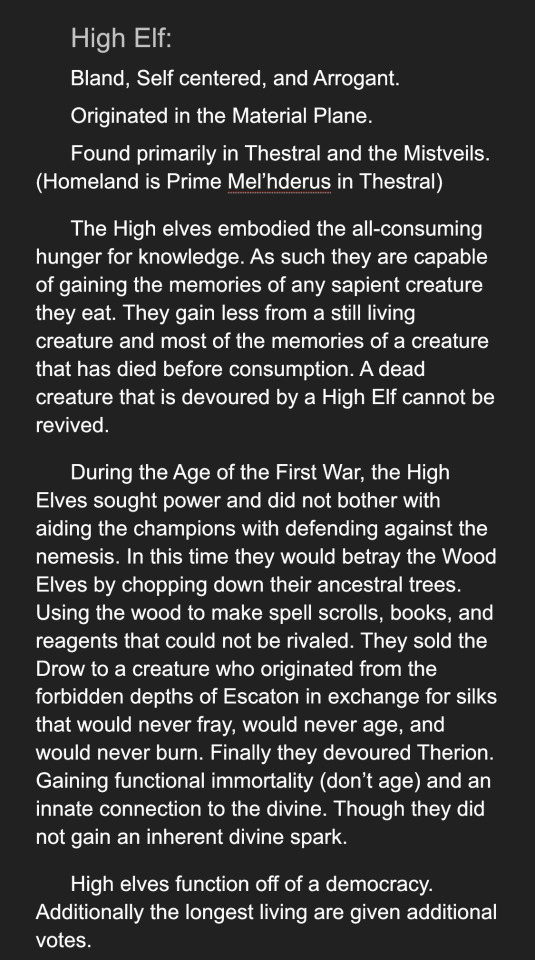
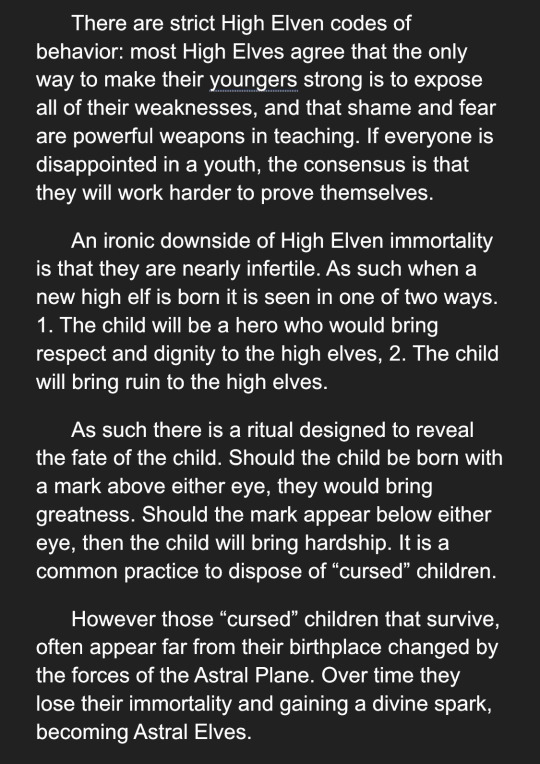
#ttrpg stuff#ttrpg#d&d 5e#d&d 5th edition#dungeons and dragons#dungeons and dragons 5th edition#lore#high elf#high elf lore#world lore
12 notes
·
View notes
Text
Alright, who wants to yell at me about D&D?
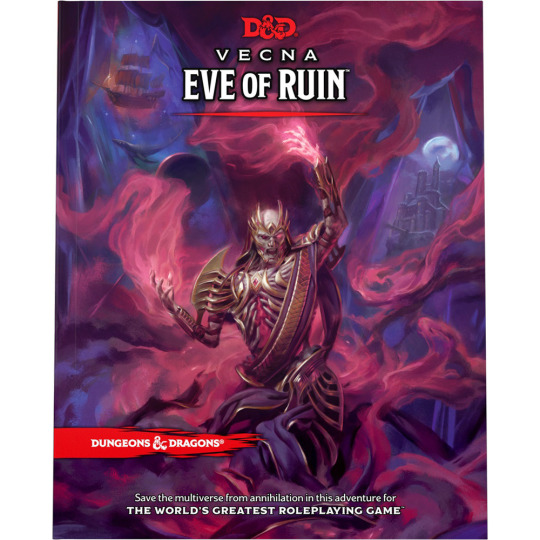
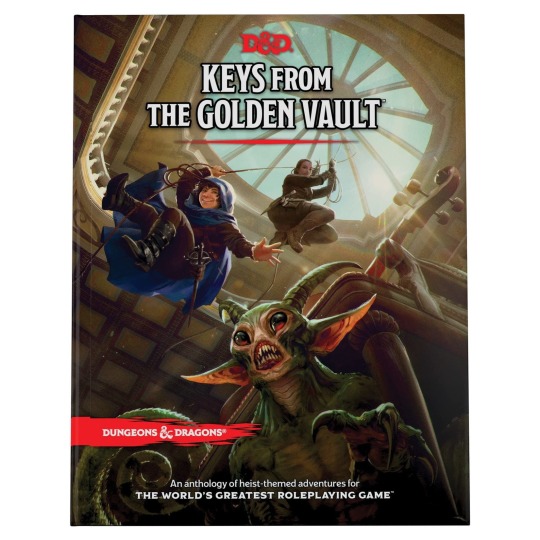
Specifically I’m interested in people’s opinions on the 5e modules; Vecna: Eve of Ruin and Keys from the Golden Vault. Mostly because I’m curious how accurate my initial judgements are.
Like, to my knowledge, Vecna: Eve of Ruin is
A tie-in with the D&D Movie (Honour among Thieves)
A update/ continuation to several older classic D&D modules (Vecna Lives and Die, Vecna Die!, amongst others).
Essentially Wizards of the Coast going “hey look at all the marketable villains we have, wouldn’t you like to see a movie about them?”
So I’m actually rather unclear as to its effectiveness as a module. I’ve been trying to adapt more older D&D material anyway lately and while I am interested in Strahd and Soth (for being the guy from ravenloft and having a fun backstory, respectively), I neither know nor care who Acerak is.
(Plus Strahd and Soth have their own books; Curse of Strahd and Hoard of the Dragon Queen, respectively)
On the other side is Keys from the Golden Vault, which is approximately 7-14 heist adventures for varying levels. While I do appreciate the “oops, all heists” premise (and some of them do sound cool conceptually), on a practical level I know I’d only run about three of them, so I’m curious if there’s anything more than that.
I should mention I haven’t actually read either of these books, so feel free to tell me how wrong I am, this is more about judging my own first impressions.
#Vecna’s just a big lich really#I know he was a god once#d&d 5e#d&d#dungeons and dragons#Keys from the Golden Vault#vecna eve of ruin#Vecna#dungeons and dragons 5th edition#5e
0 notes
Text
Thank you for this, cause Bugs is one of my favorite Looney Toons characters!
How to Play as Bugs Bunny in DnD 5e

That’s right, today we’re building the epic icon of Bugs Bunny. As the star of Looney Tunes, I could think of nobody better to start with than Bugs Bunny. Now, Bugs has a lot of tricks up his sleeve. He’s a master of disguise, misdirection, manipulation, he can pull items out of the hammerspace behind his back, and defy the laws of physics. So, clearly Bugs is some kind of all-powerful trickster. But how do we build him?
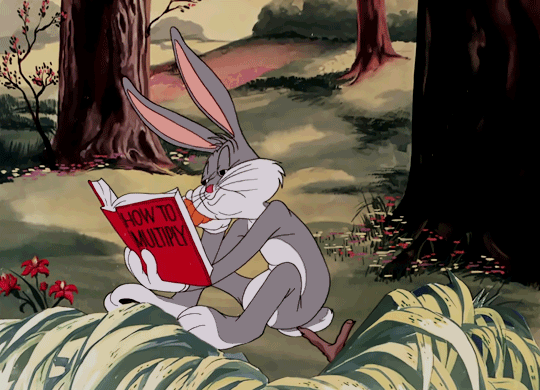
For his race, Bugs is a Harengon, a type of rabbitfolk from the feywild. We’ll give him +2 CHA, +1 DEX. As a Harengon, Bugs is a Fey type creature immune to the effects of spells like Charm Person and Hold Person that specify a humanoid target. He also gains proficiency with Perception, adds his proficiency bonus to his initiative rolls, add a d4 to a failed DEX saving throw, and jump five feet times his proficiency bonus.
For his background, Bugs is most famous for his ability to pull things over on unsuspecting maroons. We’ll label him as a Charlatan. Now, why is he not a Performer? Because Charlatans get automatic proficiency with the Disguise Kit. If there’s anything he’s known for, it’s his disguises.
In terms of Alignment, Bugs tap dances on the border between Chaotic Good and Chaotic Neutral.

BARD COLLEGE OF CREATION
Bugs is undeniably a Bard. He has a long history as a Vaudeville type performer, even canonically being a famous performer in numerous cartoons. In one, his gags with Elmer Fudd even began as a comedy routine they performed on stage, and later evolved to make them a famous comedy duo. In others, he’s a famous celebrity famed for his career in show business. So, he’s definitely a Bard. But, what College? Well, that would be the college of creation. They can create musical notes that attack people, they can pull items out of nowhere, which by 14th level can be Huge items, they can animate objects around them like some old black-and-white cartoon from the 20s or 30s, and by late game, he can make multiple items at once. As a Bard, we get any three skills, and we’ll take Performance, Persuasion, and Stealth.

Name: Bugs Bunny Race: Harengon Background: Charlatan Alignment: Chaotic Neutral
STATS STR 8 DEX 20 CON 12 INT 12 WIS 14 CHA 20
SAVING THROWS STR -1 DEX +11 CON +1 INT +1 WIS +2 CHA +11
HP: 123 AC: 15 PB: +6 SDC: 19 SAB: +11 PP: 24 Initiative: +11 Bardic Inspiration: (5) 1d12
SKILLS Deception (+17) Perception (+14) Performance (+11) Persuasion (+17) Sleight of Hand (+17) Stealth (+11)

SPELLS
C Friends, Mage Hand, Minor Illusion, Prestidigitation, Vicious Mockery 1 Charm Person, Command, Disguise Self, Silvery Barbs, Tasha’s Hideous Laughter 2 Mirror Image, Enthrall, Gift of Gab, Suggestion 3 Antagonize (UA), Dispel Magic 4 Charm Monster, Confusion, Polymorph 5 Dream, Geas, Mislead 6 Mass Suggestion, Otto’s Irresistible Dance 7 Teleport (how he often ends up in the wrong place) 8 Glibness 9 True Polymorph
BARDIC MAGICAL SECRETS 10th Counterspell, Fly 14th Fabricate, Creation 18th Contingency, Reverse Gravity

WHY NOT ROGUE?
Some may wonder why I didn’t even consider the Rogue for Bugs Bunny. After all, Rogue does have some useful features. Uncanny Dodge and Evasion go a long way to make Bugs as slippery as he is, and that’s a good point. They also get another skill, giving him the chance to pick up Insight proficiency. Sneak Attack bonus also lets Bugs capitalize on his sneaky underhanded tactics. But, there’s a good reason why I chose Bard. Firstly, Arcane Trickster Rogues work off Intelligence, and Bugs is not book smart. He’s a wise guy and a charmer, but one of his common running gags is mispronouncing common sayings, like saying maroon instead of moron. Arcane Tricksters are also cut off at the 4th level, cutting Bugs off from great spells like Creation and Mislead, which go so well with his tactics. Any other type of rogue doesn’t get any spells, which deviates from where Bugs Bunny shines as a DnD Character.

Bugs is a character I’ve wanted to build for a while. I was going to do him when the Harengon came out, and then I just kind of forgot and left him sitting on a backburner. But he can do everything I would hope for. He’s clever, charming, and most importantly of all, great at manipulating people without outright brainwashing them. Just exploiting their stupidity. And since the Bard of Creation can create just about anything out of thin air, it really lets the player let their imagination run wild. Let’s see how intimidating Strahd is after he’s had an anvil dropped on his head.
#bugs bunny#looney tunes#merry melodies#dungeons & dragons#dnd#Dungeons and Dragons#dnd 5e#fifth edition#dungeons and dragons fifth edition#dungeons and dragons 5th edition#5th edition#daffy duck#porky pig#elmer fudd
311 notes
·
View notes
Text
What Makes an Artificer?
Like I did with the Ranger a few months ago, I take some time to look at what I think the hallmarks of an Artificer should be in a 5e SRD fantasy game. #5eSRD #DnD #DnD5e #DnD2024
A while back, I picked apart what Rangers were in pop culture and games and how all of that congealed in my head to create my core concept of what I wanted in a Ranger character class. Now that WotC has released their first post-2024 Player’s Handbook Unearthed Arcana with the playtest version of the Artificer, and reading some thoughts people have had about what an Artificer is, I wanted to do…
#28#68#Artificer#Dungeons & Dragons 2024#Dungeons and Dragons#Dungeons and Dragons 5th Edition#Eberron#Unearthed Arcana
0 notes
Text


GUYS. I HAVE ART TO TUMBLE ABOUT? My husband DMs and I designed mine and my friend's characters. Stay tuned for a Minotaur too for another of my friends. They are not from a typical Fantasy Realm, they are from an altered present-day Earth Universe so Cadi's fashion..
Cadence "Cadi" Lucid My Character ☆ Human (first human ever and been playing this for over 20 years 8D) ☆ Star Druid She's a Feylost who was given a fox tail (not pictured). She does have one arm missing, she has no prosthetics, this includes magics. She lost her arm to a magic spell casted by her biological mother (she sucks) in a rage tantrum because 9 year old Cadi woke up into Druidism and not Sorcery like her family. Her surname Lucid was given to her when her Uncle Leon adopted her and changed the family name to Lucid from Stone. You bet your tail that I gave her Lucid as a name because I was listening to Lucid over and over again.
My friend's character Lady Wispa is a Faery who is a Druid (Circle of Wildfire)! She has dust that shimmers off of her ; o;. I had so much fun designing Wispa with Renn's inspo pictures.
Shameless Plug: If you have a character you would like to be designed by me... or just a character to be drawn. I do have a Ko-Fi account. This is my Art Instagram: markmybirds.art
Please do not redistribute my art without permission. The birds are watching.
#My Art#markmybirds#Mar Art#markmybirds art#The Birds are Drawing#Character Artist#Character Design#Dungeons and Dragons 5th Edition#AU Earth with Nikola Tesla Messing With Things#World Build by Draketh/Pawfoot aka my Husband#The campaign is called I Love Lamp#He gave me full naming rights..#I thought “Nikola Tesla practically made electricity. Lamps?”#There are pigeons all over the campaign Discord#Cadi played by Mar#Wispa played by Renn#Please do not Redistribute My Art#The Birds Will Get You#You've been warned
1 note
·
View note
Text
Unusual Reasons for Cleric Domains Part 1 (Arcana Through Forge)
Arcana
A trickster figure took a liking to a capable wizard, nudging them along from the shadows. When the wizard finds out, they find the arrangement very agreeable, and revere the figure as a partner in learning “new tricks.”
A cleric’s desperation to learn to resurrect led them to a life god at first, but it was the magic itself that fascinated them, so the god agreed to allow them to revere them for their magical capabilities alone.
A wizarding society has been working tirelessly to recreate the magic belonging to a “dead” god. The god, whose dormant nature is slowly beginning to change, rewards this pursuit, gives them genuine divine magic as a reward for their reverence of the figure’s magical history.
A god of the forge takes an interest in a creator of magical weapons, finding the practice novel and seeking a partnership. The creator is quick to agree.
Death/Grave
A soldier who lost far too many friends in a conflict seeks comfort in the softer side of the god of war, vowing to remind everyone that revering war means revering the dead that are left in its wake.
A caretaker for the dying reaches out to a god of stories, asking for ways to preserve and enshrine the stories of the dying into something other than simple memory. Moved by the request, the god obliges, and allows them abilities to help them in their practice along with their newfound friendship.
A holy person of the god of order or law simply sees death as the great equalizer. They seek to ensure fairness and equality, even in the very end.
A holy person working under the god of the hunt began showing disgust at the way some of their contemporaries finished a kill. Believing everything, animals included, deserve dignity in death, their path changed with the god’s full support behind them.
Forge
A community figurehead in a newly built town seeks out a god of family or home for guidance as to how to build a safe and steady home for them and their people. The god agrees, and equips them with the tools and knowledge to build whatever they may need.
In a moment years ago, a soldier was outnumbered and outgunned, barely escaping a grisly fate thanks, in part, to a cry to the war god. Now, they work as a holy person of that god as repayment for saving their life, and work to forge a weapon strong enough to prevent them from ever feeling that powerless again.
They never thought a god would take a liking to them as a weapons maker for a thieve’s guild, but when the patron of rogues and thieves, who seldom reaches out to anyone, asks them to be their dedicated keeper of a secret forge, only for those outside of the law and purview of other gods.
A god of order grows desperate for stability in a changing, uprising filled world. So they called upon a local forge master to build something better, something for a divided world to unify around. That remains their calling to this day.
#might continue this#if there’s interest#d&d#d&d 5e#dungeons and dragons#dungeons and dragons 5th edition#d&d homebrew#d&d character#d&d cleric#cleric
3 notes
·
View notes
Text
All my tieflings will be strange colors
Nothing could ever top the 5e PHB saying “Tieflings can only be normal human skintones and also red” right next to a picture of a purple tiefling
#solution: humans are purple in 5e#dnd#d&d#dungeons and dragons#dnd 5e#d&d 5e#dungeons and dragons 5th edition
16K notes
·
View notes
Text
Once again sad that I do not know how to homebrew a spellcasting-less ranger
#i cant help it#i just am not really a spellcasting fan#idk how to balance the features im putting in place of spellcasting#dnd 5e#dungeons and dragons#dungeons and dragons 5th edition#ghost.txt#ghost whines#if i could find a spellcasting free ranger that i like id probably play that like 90% of the time#i love rangers so much#rangers 5e
0 notes
Text
D&D Beyond is so fucking frustrating to use. I have the prerequisites to put the warcaster feat on my variant human, but it isn't showing for some fucking reason. It's so annoying. I'm going to use the browser version instead.
0 notes
Text
Thanks to @lost-carcosa for finding a reblog of the 'wish geese on them' post: https://www.tumblr.com/maggiemayy98/70735802074/realhousewivesofnightvale-dont-wish-death-on
D&D monster: Vengeance Goose
This was inspired by a tumblr post which I've seen in screenshot form on imgur from time to time, though I'm having trouble tracking down the original post; the gist of it is, "don't wish death on your enemies -- wish geese on them. Infinite geese."
This appealed to my sense of humour, hence the following monster statblock (partly cribbed from the 'giant goose' from the 5e supplement Bigby Presents: Glory of the Giants, specifically some of the stats and the Actions section, especially the 'Thunderous Honk' move; it was the most goose-y statblock I could find) and accompanying summoning spell. Both monster and spell are deliberately overpowered jokes, so DMs, be judicious in using them with your table -- but if you do, definitely drop me a line because I'd LOVE to hear how it goes! (There's always one Big Bad Evil Guy who'd be soooooo satisfying to take down via swarm of cactus-wielding geese >:D Mwahahaha!!!)
In my mind, this monster resembles a Canada Goose (albeit larger), but feel free to sub in whichever type of goose you consider to be especially vicious b******s! :D
------
Long ago, a wizard specialising in transmutation magic (and not getting out in the fresh air enough) was seeking a more satisfying means than mere death for getting one over on his enemies. Remembering an incident in his youth and a plant from his homeland, he captured some local geese and magically engineered them to have enhanced aggression and the abilities to single-mindedly pursue a specified target and cast cactus-summoning magic.
Unfortunately for him, his original test subjects got loose and worked out their (very understandable) grudges against him, before escaping and mingling with the local goose population. Their descendants have lost none of their aggression or spellcasting ability, and are known to be violently territorial even by the standards of goose-kind, at least where non-avian intruders are concerned.
A group of adventurers who investigated the wizard's tower after his demise found his notes and managed to reverse-engineer them, creating a spell with which to summon one or more Vengeance Geese into temporary existence to assail an immediately present target. This spell is generally safe for adventuring mages to use; attempting to capture and tame Vengeance Geese from the wild is overwhelmingly discouraged by all reputable druidic organisations and any rangers with half an ounce of sense.
Vengeance Goose
Medium Beast, typically Chaotic Neutral
Armour Class: 16 (natural armour) Hit Points: 120 (16d8+48) Speed: 30ft., fly 30ft.
STR 18 (+4) DEX 14 (+2) CON 17 (+3) INT 12 (+1) WIS 18 (+4) CHA 12 (+1)
Saving Throws Dexterity +8, Constitution +6, Charisma +7
Skills Insight +7, Perception +7, Intimidation +7
Damage Resistances magical bludgeoning/slashing/piercing, force, poison
Damage Immunities piercing (own conjured cacti only), thunder
Condition Immunities blinded, charmed, deafened, exhausted, frightened, paralysed, poisoned
Senses truesight 30ft., darkvision 60 ft., tremorsense 30 ft., passive Perception 17
Languages Understands Common, Infernal, Celestial and Draconic but can't speak
Challenge 8 (3900 XP) Proficiency Bonus +3
Traits
Aggressive As a bonus action, the goose can move up to its speed toward a hostile creature it can see.
Magic Resistance The goose has advantage on saving throws against spells and other magical effects.
Action Surge (1/day) The goose can push itself through sheer vindictive aggressiveness to take one extra nonmagical action on its turn.
Innate Spellcasting The goose's spellcasting ability is Wisdom (spell save DC 17). The goose can innately cast the following spells, requiring no material components:
At will: Primal Savagery (2d10 acid damage)
3/day each: Ensnaring Strike (3d6 piercing damage/turn), Conjure Barrage (piercing damage), Plant Growth (1-action version only, goose takes no movement penalty from conjured plants), Grasping Vine
Cactus Growth The goose's Plant Growth spell exclusively creates cacti. A creature who comes into contact with these cacti gets pieces stuck to them, which inflict 1d6 piercing damage at the start of each of its turns until it or one of its allies uses an action to remove the pieces, making a DC 15 Dexterity save to avoid getting cactus'd in turn. The goose uses pieces of the cacti for its Conjure Barrage spell.
Actions
Multiattack The goose makes one Beak attack and either two Wing attacks or one Wing attack and one use of Spellcasting.
Beak Melee Weapon Attack: +7 to hit, reach 10 ft., one target. Hit: 11 (2d6 + 4) bludgeoning damage.
Wing. Melee Weapon Attack: +7 to hit, reach 5 ft., one target. Hit: 9 (1d10 + 4) bludgeoning damage, and the target must succeed on a DC 17 Strength saving throw or have the prone condition.
Thunderous Honk (Recharge 5–6) The goose honks with ear-splitting volume. Each other creature within 30 feet of the goose must make a DC 15 Constitution saving throw. On a failed save, a creature takes 16 (3d10) thunder damage and has the deafened condition until the start of the goose's next turn. On a successful save, a creature takes half as much damage only. The honk can be heard within 300 feet.
Spell: Summon Vengeance Goose
Summon Vengeance Goose
1st-level conjuration
Casting time: 1 action
Range: 30 feet
Components: V, S, M (a goose feather and a fragment of cactus)
Duration: Special
You designate a target within range that you can see and that is hostile to you, and call forth one Vengeance Goose, which manifests in an empty space within range. The Goose shares your initiative count, taking its turn directly after yours, and attacks its designated target relentlessly. It disappears when either it or its target is reduced to 0 hit points.
At higher levels When you cast this spell with a spell slot of 2nd level or higher, 1d20 extra Vengeance Geese are summoned for each slot level above 1st. These extra geese can all manifest at once, or appear 1d20 at a time on each of your turns after casting until all of the bonus geese are accounted for or the designated target falls to 0 hit points (you choose when you cast the spell).
Classes: Druid, Sorcerer, Wizard
Note: I went for the limited-but-still-potentially-amusingly-high number of geese because infinite geese, while very much in the spirit of the post that inspired this homebrew, would have some potentially awkward consequences; see the What If xkcd article 'A Mole of Moles' for more information.
Happy dungeoneering!
#dungeons and dragons#dungeons & dragons#dnd#d&d#d&d 5e#5e#dnd 5e#dungeons and dragons 5th edition#dnd 5e homebrew#ttrpg#monster#monster statblock#spell#summoning spell#wish geese on them
5 notes
·
View notes
Text
Go read check out Unchained Mysteries by Jesse Burneko
I recently was altered to and read a treatise called Unchained Mysteries, and it’s incredible that I had never heard of it before. It’s not a TTRPG, but it is a treatise about TTRPGs, particularly mystery investigation TTRPGs, and how bad they have been for the past 50 years at actually doing investigation gameplay.
For the roughly two years since we went public with Eureka: Investigative Urban Fantasy, we have been fighting a war, an idealogical war on TTRPGs as an artform declared by monopolistic corporations, parasocial “”actual play”” shows, content mill YouTube channels and the loyal adherents of the above. The generals of this vast army, whether they consciously realize it or not, have a financial incentive to teach you that game design is not real and that it doesn’t matter. A consumerbase that understands game design or what a TTRPG is on even the narrowest, shallowest level is one where some people might sometimes choose to play something besides the most popular and heavily advertised game on the market when they are able to recognize that it does not suit their needs.
To this end they teach you “just ignore the rules when they get in the way of the story,” and “a good GM can make anything work.” They task the GM with putting on a one-man show so that people who do not like the kinds of experiences created by the rules of the most popular game do not ever have to engage with the experiences of playing the most popular game, but still buy all the most popular game’s products, and most importantly never buy anything else.
It’s been an uphill battle, but we have been able to carve out a little outpost for ourselves, convert others to the Game Design in Real faction, and occasionally make contact with like-minded individuals who fight for TTRPGs to be treated as a unique and meaningful artform and game, not just an annoying book that gets in the way of your improv session, as most self-identified fans of TTRPGs have been taught to treat them.
Unchained Mysteries is one of those times we discover a powerful ally, and it has been some real wind in my sails, lemme tell you.
As a TTRPG game designer, it really wears on the mind to get the same comments over and over and over from people who don’t even know enough about gleeblor to understand the position they’re taking, that all boil down to the same thing: Telling me that my work, and the work of others trying to design TTRPGs, is, at best, completely meaningless, because the rules we write shouldn’t be assumed to affect anything, that the right way to play TTRPGs is to just ignore the rules and make it up as you go. At worst, they get offended, and demand to know “why I’m trying to tell them how they should play the game” in the instruction manual for the game. And come at me with shonen hero monologues about how as an artist I have no right to even want people to engage with my art the way that I intentionally designed it to be engaged with, let alone have the audacity to express that desire. People’s right to not think about anything and put in the least possible effort for the quickest, shortest gratification is sacred, especially because game design isn’t real, so there’s no way that following the intent behind the design could lead to a more meaningful experience than just running off vibes.
And all this with the financial stress of being unable to keep a “normal” job due to disability, making my art my main source of income on top of the constant reaffirmation that large amounts of potential customers have been taught that the kind of art I’m best at and most passionate about, art that is really really trying to provide a particular experience through its design and intent, is the most undesirable kind of art, if they even know that kind art exists within the medium of TTRPGs at all.
Sorry about all that.
Anyway, it would have been cool to find such a well-written piece of writing that agrees with Eureka’s stance on investigative TTRPG gameplay on one point.
It would’ve been really cool to find such a well-written piece of writing that agrees on two points.
The points made, the problems highlighted, and the solutions proposed within Unchained Mysteries are about a 90% overlap with Eureka: Investigative Urban Fantasy’s, and presents them even more convincingly. (Which is to be expected, since it exists only to make these points rather than also being a whole game.)
If you’re interested in the arguments Eureka: Investigative Urban Fantasy makes and demonstrates about game design, give Unchained Mysteries a read.

#indie ttrpg#ttrpg tumblr#ttrpg community#rpg#ttrpgs#ttrpg#indie ttrpgs#eureka ttrpg#actual play#dnd#d&d 5e#d&d#dungeonsanddragons#starfinder#dungeons and dragons#critical role#dimension 20#d&d 5th edition#d&d 5.5e#wotc#eureka: investigative urban fantasy#eureka
164 notes
·
View notes